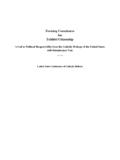Transcription of From States Systems to a Society of States: The Evolution ...
1 international relations From States Systems to a Society of States : The Evolution of international relations - K. J. Holsti FROM States Systems TO A Society OF States : THE. Evolution OF international relations . K. J. Holsti University Killam Professor, Political Science, University of British Columbia, Vancouver, CANADA. Keywords: States Systems , Society of States , Peace of Westphalia, Concert of Europe, League of Nations, United Nations, right of conquest, international institutions Contents States Systems The Characteristics of Relationships in States Systems S.
2 TE S. 2. Mediaeval European Cosmology and Politics 3. Origins of the European States System R. AP LS. 4. The Peace of Westphalia (1648). The Legacies of Westphalia 5. The Legacy of the Napoleonic Wars: The Concert of Europe and the Management of C EO. the States System 6. The Universalization of the European States System: Imperialism 7. The Legacies of the Great War 8. The Legacies of World War II. E . 9. Managing the Postwar international System H. Managing the Cold War PL O. The Problem of Weak States 10. Revising Westphalia: A New Norm for Intervention?
3 M SC. 11. The Territorial Compact 12. From System of States to a Society of States : international Institutions Glossary Bibliography SA NE. Biographical Sketch Summary U. In the long history of human political organization, Systems of States have developed less frequently than loose, sedentary empires. The historical examples of States Systems , such as those of the Greeks, show the development of rudimentary international institutions such as diplomacy and trade, but war, conquest, and slavery were the most notable correlates of political independence.
4 Most Systems of States eventually collapsed through constant warfare, to be taken over by neighboring empires and kingdoms. European States began to form in the fifteenth century. Through war, religious heresy, and propaganda, they eventually replaced the mediaeval respublica Christiana, the theoretically organic community under the sovereignty of God, as mediated by the papacy. After the Thirty Years' War (1618-1648), the new European States sought to create a stable international anarchy by developing international law and a territorial balance of power.
5 These contrivances did not significantly reduce the incidence of war, Encyclopedia of Life Support Systems (EOLSS). international relations From States Systems to a Society of States : The Evolution of international relations - K. J. Holsti as the old idea of a unified Europe under the hegemony of a single state continued to animate the likes of Louis XIV, Napoleon, the Germans during World War I, and Adolf Hitler. Each was the source of pan-European wars, followed by major peace treaties that established mechanisms for management of the States system.
6 In 1815, it was the Concert of Europe. In 1919, the Paris Peace Conference established the League of Nations. The United Nations was the main legacy of World War II. Its efforts to manage the system were largely unsuccessful because of the Cold War and the problem of domestic wars in many post-colonial and Balkan States . Nevertheless, rules regulating relations between States have strengthened substantially and as a result we have seen a dramatic decline in the incidence of interstate war since 1945, an increasing sanctity of territorial integrity, and in general more international peace and security.
7 The main problem in the contemporary system is no longer war between States , but civil strife, collapse, and humanitarian emergencies within certain kinds of States . S. TE S. R. AP LS. We can call the contemporary system of States an international Society , or Society of States , because over the past several centuries most of the forms of interaction between States have become regulated by laws, norms, and institutions. Among the more C EO. significant rules are the non-use of force, respect for the sovereignty of member States , non-interference in their internal affairs, respect for territorial integrity, de- legitimization of the right of conquest, trade laws, and respect for human rights.
8 The Society of States is analogous to a club: members who wish to join must demonstrate respect for its rules. Those who break the rules are subject to censure, sanctions, and E . other forms of ostracism. H. PL O. 1. Early States Systems M SC. Since man began to organize into sedentary political units more than ten millennia ago, domination and subordination have been the predominant structural characteristics of relations between diverse polities. The hierarchical form of relationships has usually SA NE. been in the form of sedentary empires, varying arrangements of suzerainty or dominion over lesser, subordinate, and dependent political structures.
9 Empires could be "loose,". with very substantial autonomy for its constituent units. The center was generally U. content with symbolic forms of superiority such as annual payments or other symbolic expressions of fealty. Otherwise, the lower units enjoyed substantial autonomy. This was the essential structure of the ancient Chinese empire prior to 771 BC, and more recently of the Ottoman Empire. Effective forms of central control through military occupation, developed bureaucracies, and surveillance and taxation of subordinate units characterized other empires.
10 A prime example was the Roman Empire. There were relationships between early empires, but we could not claim that they constituted international Systems because the intensity of relations was low, and usually concerned only one sector such as trade in luxuries. We have records of trade between Rome and Han China in the second century BC, but there was no formalized diplomatic-military relationship. Similarly, by the fifth century BC, the Chinese had commercial relations with small kingdoms in what is now Indonesia, but they were irregular and seldom spilled over into the military-diplomatic realm.
















